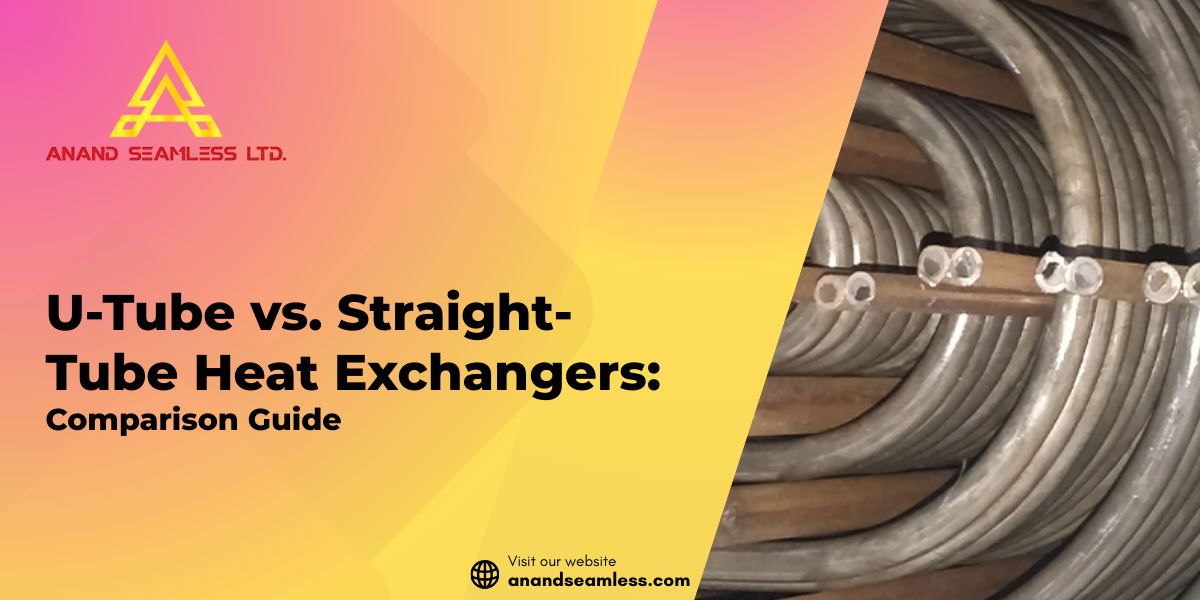Quick Inquiry
Heat exchangers play a crucial role in industries that depend on efficient thermal energy transfer between fluids. From power plants and chemical processing to HVAC systems and marine operations, choosing the right heat exchanger design directly influences efficiency, maintenance requirements, and overall operational costs. Two of the most common designs are U-tube heat exchangers and straight-tube heat exchangers. Each has distinct advantages and limitations depending on the application. This guide provides a comprehensive comparison to help businesses determine the best fit for their needs.

What Are U-Tube Heat Exchangers?
U-tube heat exchangers feature tubes bent into a U-shape, allowing fluid to enter one end, circulate through the U-shaped tubes, and exit at the same side of the exchanger. This design eliminates the need for expansion joints since the tubes naturally expand and contract during temperature changes.
Advantages of U-Tube Heat Exchangers
- Effective Thermal Expansion Handling: U-tubes can freely expand and contract, making them highly resistant to stress caused by temperature fluctuations. This feature makes them ideal for high-temperature applications such as power plants, oil refineries, and industrial boilers.
- Compact Design: The U-shaped configuration reduces the overall footprint, making these heat exchangers suitable for installations with space constraints.
- Cost-Effective: With fewer components than straight-tube designs, U-tube heat exchangers require less material and are generally more affordable to manufacture and install.
- Durability: Their robust construction ensures long-term performance with minimal risk of leakage due to the reduced number of welded joints.
Challenges of U-Tube Heat Exchangers
- Difficult Maintenance: The curved tube design makes it challenging to clean the interior, particularly for applications where fluids are prone to fouling.
- Tube Replacement Complexity: If a tube gets damaged, replacing it requires dismantling the entire bundle, which can be time-consuming and costly.
What Are Straight-Tube Heat Exchangers?
Straight-tube heat exchangers, as the name suggests, consist of tubes running in a linear fashion between two tube sheets. They come in two configurations: a fixed tube sheet and a floating head. The floating head design allows for thermal expansion, while the fixed tube sheet design requires expansion joints to compensate for temperature-induced stress.
Advantages of Straight-Tube Heat Exchangers
- Easy Cleaning and Maintenance: The straight tube design allows for simple mechanical or chemical cleaning, making them ideal for industries that require frequent maintenance, such as food processing and pharmaceuticals.
- Efficient Inspection and Tube Replacement: Individual tubes can be easily inspected and replaced without dismantling the entire bundle, reducing downtime and repair costs.
- Versatile Configuration Options: Available in both fixed tube sheet and floating head designs, offering flexibility for various industrial applications.
- Long-Term Maintenance Efficiency: The accessibility of the tubes makes them a preferred choice for businesses prioritising long-term operational ease.
Challenges of Straight-Tube Heat Exchangers
- Thermal Stress Risks: The fixed tube sheet design, unless equipped with expansion joints, is susceptible to thermal stress, which can lead to cracks and leaks over time.
- Larger Space Requirement: Straight tubes generally require more space for installation compared to their U-tube counterparts, making them less suitable for compact industrial setups.
Comparing U-tube and Straight-Tube Heat Exchangers
Performance and Application Suitability
When choosing between U-tube and straight-tube heat exchangers, several factors must be considered. U-tube heat exchangers excel in high-temperature applications and are more compact, while straight-tube counterparts offer easier maintenance and better tube accessibility.
The nature of the process fluid is another crucial factor. If the application involves dirty or viscous fluids, straight tubes are preferable due to their ease of cleaning. On the other hand, U-tubes are better suited for clean fluids operating at high temperatures.
Maintenance and Cleaning Considerations
Maintenance requirements also play a significant role in the decision-making process. Industries that require frequent tube inspections and replacements, such as food processing and pharmaceuticals, will benefit from straight-tube heat exchangers. Conversely, U-tube heat exchangers work well in settings where minimal fouling occurs and maintenance is less frequent.
Space and Installation Constraints
Space constraints should also be taken into account. U-tubes are more compact and can fit into tighter spaces, whereas straight-tubes require more room for installation and operation.
Cost Considerations
Finally, cost considerations may influence the decision. U-tube heat exchangers are generally more cost-effective upfront due to their simpler design. However, straight-tube heat exchangers, particularly floating head models, may have higher initial costs but lower long-term maintenance expenses.
Call Us Now for a Free Quote!
Comparison Table
Feature |
U-Tube Heat Exchanger |
Straight-Tube Heat Exchanger |
| Design | U-shaped tubes | Straight tubes |
| Thermal Expansion Handling | Naturally accommodates expansion and contraction | Requires expansion joints or a floating head design |
| Cleaning & Maintenance | Difficult due to curved tubes | Easier due to straight tubes |
| Tube Replacement | Requires dismantling the entire bundle | Individual tubes can be replaced without fully dismantling |
| Space Requirements | Compact design, ideal for tight spaces | Requires more space for installation |
| Cost | More cost-effective due to simpler design | Higher initial cost, but may have lower maintenance expenses |
| Ideal Applications | High-temperature industries like power plants and refineries | Industries requiring frequent maintenance, like food processing and pharmaceuticals |
Select the Right Heat Exchanger Manufacturer
Choosing between U-tube heat exchangers and straight-tube heat exchangers ultimately depends on operational requirements, budget, and maintenance considerations. Businesses should partner with a trusted heat exchanger tube manufacturer to ensure they receive high-quality materials that enhance efficiency and durability.
In addition, it’s crucial to evaluate the manufacturer’s industry expertise, compliance with international standards (such as ASME and ASTM), and ability to provide customised solutions tailored to specific applications. A reputable company will offer technical support, material traceability, and advanced fabrication techniques to optimise heat transfer performance and ensure long-term reliability in demanding environments.
Upgrade Your Operations with High-Quality U-Tube Heat Exchangers
Selecting the right heat exchanger is crucial for optimising industrial performance and reducing long-term operational costs. Whether you require the durability and compact design of U-tube heat exchangers or the easy maintenance and efficiency of straight-tube heat exchangers, our team can provide customised solutions tailored to your specific needs.
As a leading heat exchanger tube manufacturer, Anand Seamless Limited offers premium-quality tubes engineered for maximum durability, heat transfer efficiency, and reliability. Our products are designed to meet the rigorous demands of power plants, chemical processing, food manufacturing, and more.
- Precision Engineering: Manufactured with strict quality control for optimal heat transfer and performance.
- Custom Solutions: Tailored tube materials, sizes, and configurations to suit your industrial applications.
- Reliable Support: Expert guidance in choosing the best heat exchanger tubes for your system.
Contact us today at +91-9099996853 for a free consultation. We will be happy to help you.
lATEST BLOG |
|
Finned Tube Heat Exchanger Selection Guide for Rice Mills, Dairy and Food Plants in India
A finned tube heat exchanger is one of the most im |
|
Why Cold-Drawn Tubes Are the Best Choice for Aerospace Component Manufacturing
When it comes to aerospace manufacturing, the sele |
|
How Seamless Steel Pipes Ensure Safety in High‑Pressure Boiler Systems
When it comes to ensuring the safe operation of hi |
|
Why Seamless Tubes and Pipes Are Gaining Popularity in Heavy-Duty Industries
In the world of heavy-duty industries, where high |
|
How Finned Tubes Help Combat Fouling in Heat Exchangers: Solutions for Clean Heat Transfer
Heat exchangers are the heart of many industrial s |

